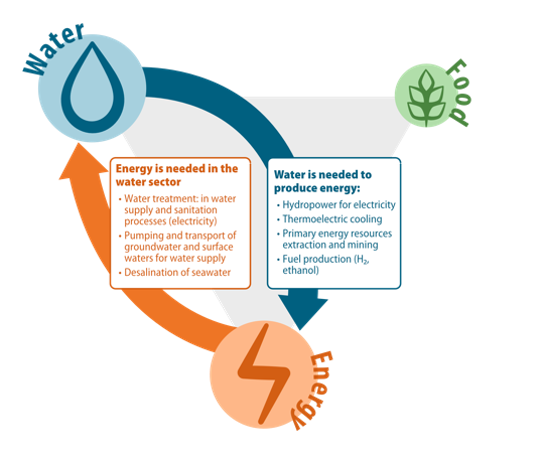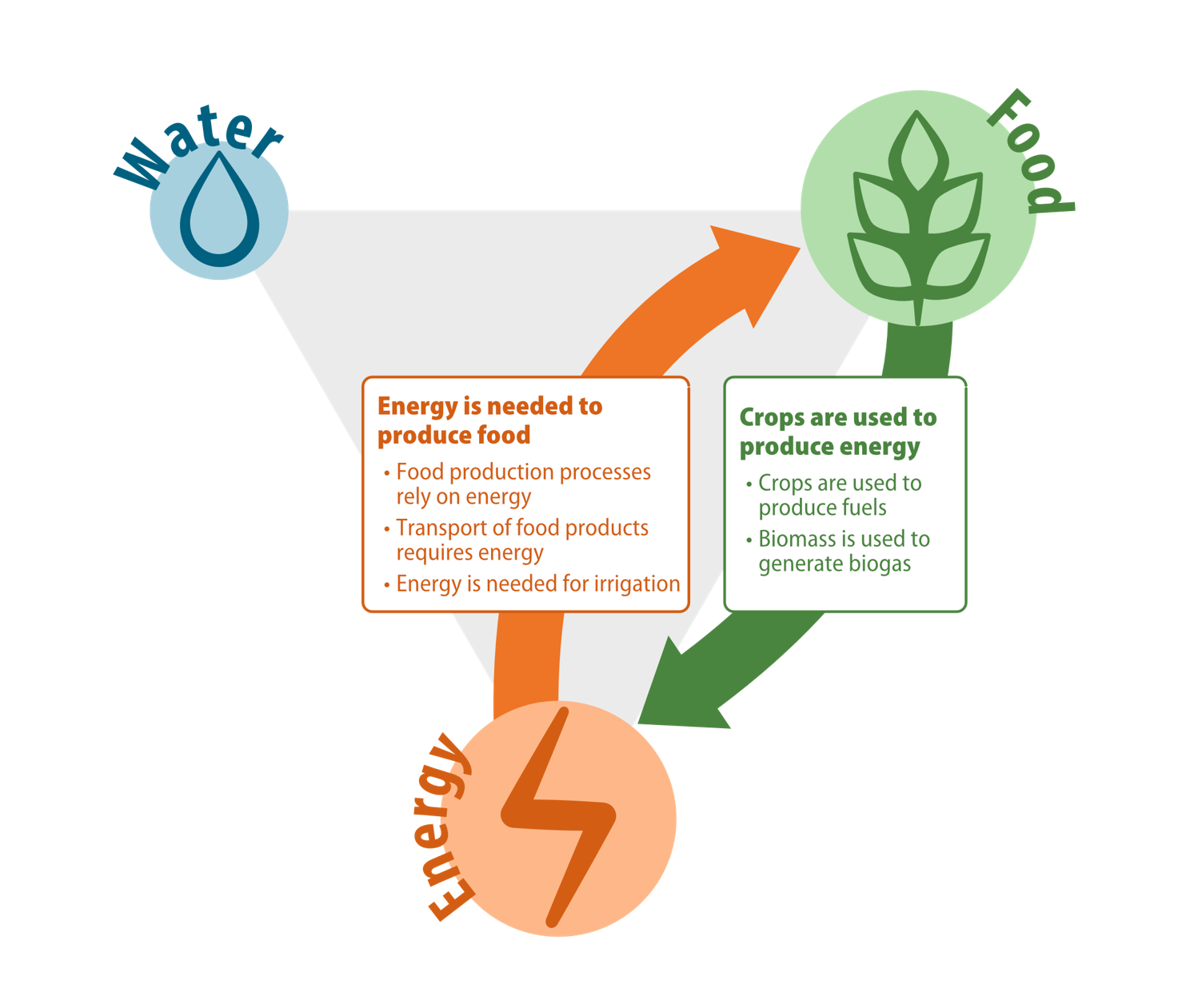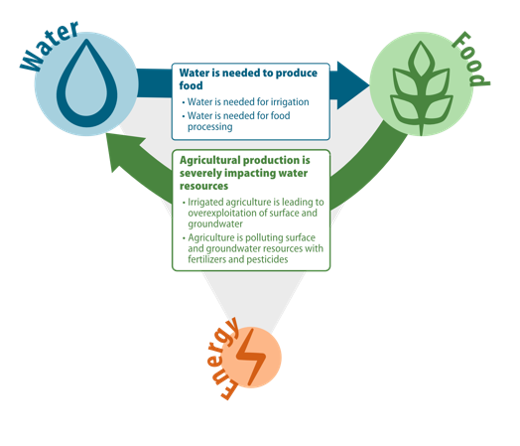1.2 Nexus-Interconnections: The WEF sectors are closely related
The WEF Nexus framework shows that the three sectors are strongly linked, and that actions in one sector can have impacts on one or both of the other sectors. In the following sections, we would like to highlight the key interconnections and important it is to have an integrated view of WEF sectors and the environmental resources needed for each of them.
In this context, we need to be aware that Agriculture accounts for 70% of total global freshwater withdrawals (FAO, 2014), 90% of energy produced today is water-intensive (WWAP, 2014), and agriculture and food chains account for 33% of global energy demand.
1.2.1 Interconnections between Water and Energy

Source: Alexandra Nauditt, Antonia Fedlmeier
The figure above introduces you to some examples for interconnections between water and energy.
Key questions addressed are:
- How relevant are water resources for energy generation and security?
- What are the implications of energy production on the quantity and quality of water resources?
Water is used for extraction, mining, processing, refining, cooling power plants and residue disposal of fossil fuels, as well as for growing crops for biofuels and hydropower. The water quantity needed varies in the energy sector, with oil and gas production requiring much less water than oil from tar sands or biofuels. Many forms of energy production through fossil fuels are highly polluting in addition to being water demanding, especially extraction from tar sands and shale and extraction through hydraulic fracturing. Furthermore, return flows from power plants to rivers are warmer than the water that was taken in, and/or are highly polluted and can consequently compromise other downstream usage, including ecosystems.
On the other hand, energy is required for water abstraction, pumping for irrigation, wastewater treatment and also for treating and distributing safe drinking water. The energy intensity required to access a cubic meter of water varies: accessing local surface water requires far less energy than pumping groundwater, reclaiming wastewater or desalinating seawater. Irrigation is more energy intensive than rain-fed agriculture, and drip irrigation is even more intensive because the water must be pressurized.
1.2.2 Interconnections between Energy and Food

Source: Alexandra Nauditt, Antonia Fedlmeier
This figure introduces you to some examples for interconnections between food production (including land) and energy.
The key questions addressed are:
- How much energy is needed for food production and security?
- To what extent should agricultural products contribute to energy generation?
The increased food security that has resulted from agricultural mechanization has strongly increased the energy demand. The food production and supply chain claims approximately 30% of total global energy demand (Popp et al., 2014).
Agricultural products versus biofuels is an important trade-off: The use of agricultural land for biofuels will further stress food production agriculture. The FAO projected that biofuel production by 2030 will require 35 million hectares of land, an area approximately the size of France and Spain combined (FAO, 2008). By 2050, there is a projected 60% increase in required food production (FAO, 2012), and achieving this increase will be difficult because of rising energy prices, depletion of aquifers available for water withdrawal, and the continuing loss of farmland to urbanization.
The energy sector can also have negative impacts on the food sector when mining for fossil fuels, deforestation for biofuels reducing land for agriculture, ecosystems and other land uses.
1.2.3 Interconnections between Water and Food

Source: Alexandra Nauditt, Antonia Fedlmeier
And finally, here you find examples for interconnections between water and food.
The key questions addressed are:
- How much water is needed for food production and security?
- What are the implications of agricultural activities on the quantity and quality of water resources?
In 2014, approximately 70% of the global water withdrawal was used for irrigation. The vast majority (96%) of global water withdrawals are from freshwater sources, i.e. lakes, rivers and underground sources (FAO, 2014). On the other hand, agricultural production worldwide leads to severe surface and groundwater water quality degradation. Farms discharge large quantities of agrochemicals, organic matter, drug residues, sediments and saline drainage into water bodies. The resultant water pollution poses severe risks to aquatic ecosystems, human health and productive activities (UNEP, 2016).
Trade-offs to be highlighted:
- Irrigation: Food production vs. water scarcity (demand higher than availability)
- Food production vs. deteriorated water quality (diffuse pollution with nutrients and pesticides)
References
1.2 Nexus-Interconnections: The WEF sectors are closely related
FAO (2014), ‘The Water-Energy-Food Nexus - A new approach in support of food security and sustainable agriculture’, Food and Agriculture Organization of the United Nations, pp.1–11.
WWAP. The United Nations World Water Development Report (2014). Water and Energy; World Water Assessment Program, UNESCO: Paris, 2014.
1.2.1 Interconnections between Water and Energy
WWAP. The United Nations World Water Development Report (2014). Water and Energy; World Water Assessment Programme, UNESCO: Paris, 2014.
1.2.2 Interconnections between Energy and Food
FAO (2008), ‘Climate change, biofuels and land’, Available from: http://www.fao.org/tempref/docrep/fao/010/i0142e/i0142e05.pdf
FAO (2012), ‘World Agriculture towards 2030/2050: the 2012 Revision’, ESA Working Paper No. 12-03. Food and Agriculture Organization of the United Nations, Rome, Italy.
Popp, J., Lakner, Z., Harangi-Rákos, M. & Fári, M. (2014), ‘The effect of bioenergy expansion: Food, energy, and environment’, Renewable and Sustainable Energy Reviews, vol. 32, pp. 559-578.
1.2.3 Interconnections between Energy and Food
FAO (2014), ‘Water Withdrawal’, Prepared by AQUASTAT, Available from: http://www.fao.org/nr/water/aquastat/infographics/Withdrawal_eng.pdf
OECD (2017), ‘Diffuse Pollution, Degraded Waters: Emerging Policy Solutions’, OECD Publishing, Paris.
United Nations Environment Programme (UNEP) (2016). ‘A Snapshot of the World’s Water Quality: Towards a global assessment’, Nairobi, United Nations Environment Programme (UNEP).